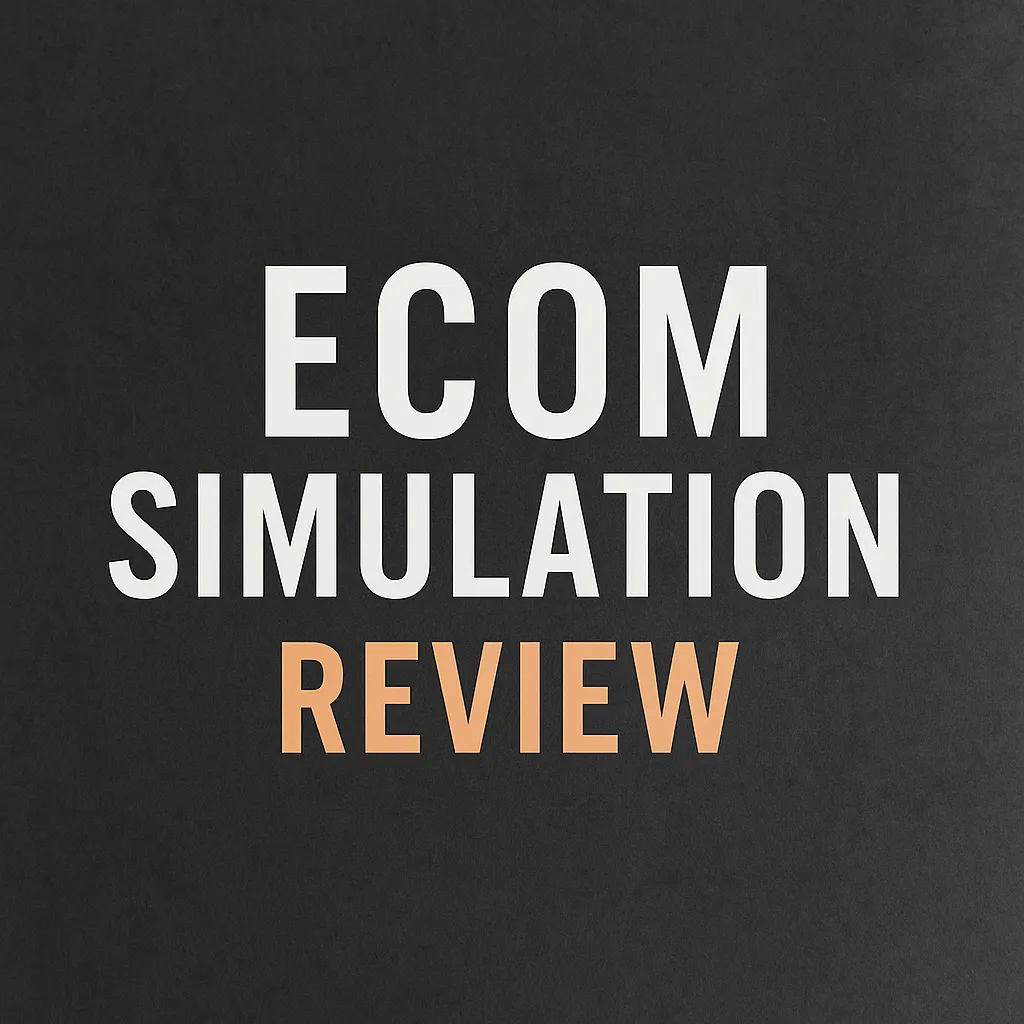Ecom Simulation Review - Is Andy Stauring's Course Worth it?
Welcome to this Ecom Simulation review. After going through Andy Stauring's program, my overall impression is that it’s a structured but fairly standard eCommerce training built around Shopify dropshipping and Facebook Ads.
It’s not a scam — Andy himself seems legitimate and has a real presence online — but the course isn’t the magic shortcut it’s sometimes portrayed as.

The core training covers the usual topics: product research, store setup, ad testing, and scaling.
It’s presented clearly, though much of the material feels similar to what you’d find for free on YouTube — including some of Andy’s own videos.
What stands out is that the course walks you through a specific “simulation” approach meant to reduce risk by testing multiple stores or products in parallel.
In theory, that’s smart, but in practice it still costs real money to execute.
From my experience, the program is best suited for motivated beginners who don’t mind trial and error and already have a few hundred dollars to spend on ad testing.
If you’re hoping for plug-and-play results or passive income, you’ll likely be disappointed.
Pros
Clear explanations and good pacing for beginners
Andy appears genuine and active in his community
Teaches fundamentals that actually apply to real stores
Cons
No verified student success data publicly available
Content overlaps with Andy’s free YouTube videos
Advertising and testing costs were not clearly discussed upfront
If you’re at that point where every new eCommerce system sounds promising but you’re still unsure which ones actually deliver, I’d suggest taking a step back before jumping in.
You can get a clearer picture of what really works — and why most people miss it — by reading this short breakdown. It helped me set real expectations before spending another dollar online.
What's Inside Ecom Simulation?
Once inside the members’ area, it became clear that Ecom Simulation isn’t built around some secret strategy or custom tool — it’s a structured training program focused on helping people launch, test, and scale Shopify stores using Facebook Ads.
The “simulation” term refers to the process of treating every store or product launch as a controlled test rather than an all-or-nothing bet.
The training is divided into several phases, starting with mindset and niche research, then moving into store setup, product selection, and advertising.
It’s designed for beginners, and most of the explanations are simple enough for someone who’s never run an online business before.
Andy focuses on testing multiple products early on to see which gain traction, then uses the data to scale the winning ones.
There’s a lot of emphasis on systems and repeatable frameworks — something Andy calls “simulation cycles.”
Essentially, you launch a product, track performance, kill what doesn’t work, and double down on what does.
It’s a smart, practical way to minimize risk, but it’s still very dependent on ad budget and execution.
Aside from the core training videos, there are occasional Q&A recordings and examples from Andy’s own stores.
That’s a nice touch, though I noticed there wasn’t much in the way of community access or one-on-one mentorship unless you pay extra.
There’s also no dedicated software, automation, or prebuilt store included — just standard guidance on using Shopify, Facebook Ads Manager, and AliExpress or other suppliers.
Overall, the course delivers a structured pathway for beginners to understand the e-commerce process.
But if you’ve been around the dropshipping world for a while, you’ll likely recognize most of what’s taught here. It’s practical, not groundbreaking.
My Personal Experience With Ecom Simulation

When I first signed up for the program, I wasn’t sure what to expect. The marketing made it sound like a unique, data-driven approach to e-commerce — something that could simulate store performance before actually scaling.
That concept alone caught my attention. I’ve seen dozens of Shopify courses that recycle the same playbook, so I was curious if this one actually offered something different.
Once I got access, I noticed the dashboard was clean and straightforward. The lessons were short and easy to digest, which I appreciated.
Andy’s teaching style is direct and calm — no unnecessary hype or dramatic claims. He walks you through niche research, supplier selection, store setup, and ad creation in a logical sequence.
For beginners, it’s definitely less overwhelming than most other e-commerce programs I’ve tried.
But as I worked through it, I couldn’t help feeling a sense of déjà vu. Much of the content reminded me of what’s freely available on YouTube — including from Andy himself. The “simulation” aspect, which the name heavily leans on, wasn’t an actual software or tool.
It was more of a testing framework — launching multiple product variations or ad sets to gather data faster. It’s a solid approach, but nothing revolutionary.
What stood out more than the lessons themselves was how Andy framed failure. He talks openly about products that flopped and emphasizes learning through repetition. That part felt authentic.
Still, the missing piece for me was proof. I didn’t see verifiable case studies, and while Andy shares screenshots and anecdotes, I prefer real student stories that show consistent results.
Would I call it a scam? No. But it’s also not a guaranteed shortcut. It’s a solid introduction to e-commerce from someone who clearly knows the space — yet if you’ve already been exposed to dropshipping fundamentals, most of it will feel familiar.
If you’ve ever felt confused about which systems actually move the needle versus which ones just sound good on paper, you can read what helped me figure that out here.
How Much Does Ecom Simulation Cost?
When I first looked into this program, I assumed it would be priced like most other eCommerce trainings — maybe around a thousand dollars or less.
But once I actually got into the sales process, I learned the full investment for Ecom Simulation was around $8,500.
That number wasn’t listed anywhere publicly; it only came up after the application and consultation call.
I later saw on Reddit that the price can fluctuate slightly, but it’s consistently positioned as a high-ticket mentorship, not a typical online course.
That was a bit of a surprise. For that kind of money, I expected a lot more than just a few training modules or a private community.
The pitch emphasized personal guidance and a step-by-step system for building and scaling stores, which sounds great in theory — but I’ve learned that high price tags don’t automatically equal better outcomes.
What really matters is how much personal involvement you actually get and how realistic the support is once you’ve paid.
Beyond the program cost itself, there are additional expenses you’ll need to factor in.
You’ll still be responsible for your Shopify subscription, which starts at $39/month, and you’ll need to budget for product testing and ads — at least a few hundred dollars just to get through the early phases.
If you’re running Facebook ads the way the training recommends, expect to spend anywhere from $1,000 to $2,000 per month while you’re testing and scaling.
There’s also the matter of apps, automation tools, and suppliers. Those monthly tools can easily add another 400 to your total.
In other words, this isn’t an under-$10k experience — it’s closer to a five-figure investment once you include everything.
For some people, that level of investment makes sense if they want deep mentorship and already have capital to reinvest.
But if you’re just starting out, it’s a heavy price to pay for something that still involves a lot of trial, error, and ongoing costs.
Ecom Simulation Pros
Polished onboarding and structure – The setup and learning flow are smooth, giving the impression of a well-organized, professional operation.
Some useful ad-testing strategies – A few of the marketing lessons were practical, especially for those unfamiliar with scaling or analyzing campaign data.
Active community – The private group was responsive and engaging, though much of the advice overlapped with what’s already available for free.
Ecom Simulation Cons
High upfront cost – At around $8,500, this is a major investment for something that still relies heavily on standard eCommerce principles.
Additional hidden expenses – Beyond the program fee, you’ll need several thousand more for ads, apps, and tools to even test products properly.
Coaching inconsistency – Some mentors provide great feedback, but others seem to follow a script rather than tailoring their advice to your store.
Familiar content – A lot of the training recycles material that experienced dropshippers have already seen elsewhere.
Not suited for beginners – The price point and ad spend expectations make it unrealistic for anyone starting with limited funds.
Overall, it feels like a structured, visually appealing program that doesn’t quite justify its high price unless you’re already comfortable navigating the risks of paid ads and product testing.
Final Verdict
After spending time inside Ecom Simulation, my overall takeaway is that it’s a well-packaged but overvalued program.
The training quality itself isn’t bad — the modules are clear, the presentation is clean, and there’s some genuine value in the ad-testing strategies.
But for nearly $8,500, I expected a deeper level of mentorship and more individualized support than what I actually received.
The “simulation” concept is interesting on paper, but it doesn’t fully live up to the idea of being guided through a real-world eCommerce experience.
Once you’re past the onboarding and initial calls, much of the process still falls on you.
The content structure feels familiar, similar to what you’d find in other premium dropshipping courses priced much lower.
That doesn’t mean it’s a scam — it’s not. It’s a legitimate, well-produced program with real support and structure behind it.
But legitimacy doesn’t automatically make it a smart investment for everyone. If you already have capital to spend, want accountability, and value a systemized path, you might find it motivating.
But if you’re expecting secret methods or a done-for-you process, you’ll likely be disappointed.
In my experience, this is one of those cases where the price tag outpaces the originality.
It’s not a bad program — just not as revolutionary as it’s marketed to be. Sometimes, paying more doesn’t mean you’re getting more; it just means you’re buying confidence packaged as mentorship.
If you’ve ever been caught in that same loop of testing new systems and wondering whether the next one will finally click, I get it.
Before I made sense of what actually moves the needle, I wasted plenty of time chasing polished promises. You can see what finally helped me cut through the noise here.